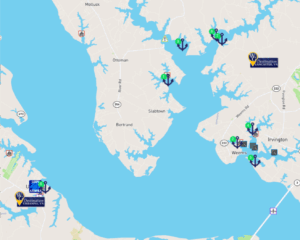By Margaret Bonds Podlich
When you hire a marine surveyor in the U.S., they’ll check all the systems and look closely at different parts of the boat, both in the water and out. The resulting written survey report will include specific concerns, cite the correlating ABYC Standard, and make recommendations for action.
What are ABYC Standards, and why are they important for a boat owner?
There are relatively few U.S. laws and regulations addressing how recreational boats should be built and repaired. Instead, since 1954, the nonprofit American Boat & Yacht Council (ABYC) has developed, maintained, and updated voluntary safety standards for boat design, construction, repair, equipment, and maintenance. The U.S. Coast Guard works closely with ABYC, and now more than 90% of the boats constructed in the U.S. are built to ABYC Standards. With all standards being reviewed and painstakingly updated by public committees at least every five years, they are much easier to amend than they would be if they were written into federal law. For those topics covered in federal law, for example, navigation lights, ignition protection, and gasoline systems, the ABYC Standards mirror the existing federal regulations.
What are some examples of ABYC Standards in boats?
To move a powerboat throttle from reverse to forward, you have to pull the neutral holding lock, then ease the shift handle forward. That lock has not always been there, but it’s a direct result of an ABYC safety standard, developed to address a particular cause of accidents.
There are other very practical answers within the standards. How high should lifelines be? (minimum of 24”) What size wire is big enough to handle the power demands of a newly installed bow thruster? How quickly should a cockpit drain? There are ABYC standards for sewage, water, electrical systems, engines, batteries, lightning protection and more. The recent rise of electrical motors with Lithium Ion batteries has sparked ABYC to revise information on electrical systems, battery switches, and batteries.
Is there a way to read these standards?
Yes, but….. The standards are available online and printed for sale in a (very thick) book. (Like the phone book you had to sit on to eat at your grandmother’s holiday table.)
You can get a FREE 5-day trial online access to all current standards:
https://abycinc.org/abyctrial/
But …..Warning: The standards are written by and for engineers, so they are not always easy to understand.
If you are doing a lot of maintenance, or you are in the industry, you might consider an ABYC membership to gain access to both the standards and the standard writers. ABYC staff members are very accustomed to answering in-depth questions about very specific topics and are quite accessible via email and phone.
ABYC also has a lot of online training, some of it free to the public, some of it for members only, on many different levels of expertise. Check out their educational offerings, including a free webinar outlining the 2024 Standards changes, on their website: Abycinc.org.
I’ve seen marina signs that say “ABYC Certified Techs” on staff. What does that mean?
There are more than 4500 seasoned professionals in North America who have gone through multi-day classes and tests to become an “ABYC Certified Tech” on a specific topic. Those topics now include: Marine Standards, Systems, Electrical, Gas/Diesel Engines & Fuel Systems, Corrosion, and Composites. Master Technicians are certified in multiple topics.
When you hire an ABYC Certified Tech to work on your boat, you know they have received specific training on their topic, and they have access to current standards to refer to in their work. It’s quite similar to having an ASE qualified mechanic work on your car.
So what is the deal with older boats? Is there “grandfathering” when it comes to the Standards?
Owners/purchasers of older or foreign-made boats may get frustrated with a U.S. survey report that cites current ABYC Standards. How is a boat built decades ago supposed to comply with standards revised this year?
We spoke to Derek Rhymes, a NAMS Certified Marine Surveyor, a SAMS Accredited Marine Surveyor, and owner of All Boat & Yacht Inspections in Annapolis. Ironically, just hours earlier he’d surveyed a 1985 C&C 35, so he wasn’t surprised with the question.
Derek reinforced the idea that survey results are not mandates. There are many ABYC Standards that are voluntary (those that don’t mirror federal law). And there is no grandfathering. Even for older boats. All boats are looked at with the current year’s ABYC Standards.
He also explained that there’s a lot of judgment calls in surveying. When he surveys, he finds an area of concern, then identifies the applicable ABYC standard, and subsequently states the resolution to that issue in the survey report. It’s up to the boat owner to determine how they may (or may not) resolve that issue or get the work done.
According to Rhymes, “Sometimes It’s unreasonable to make an older boat fully compliant with current standards, but there are some things that are relatively easy to address that can make the boat much safer.”
For example, at home we now have GFCI outlets in bathrooms, but an older boat may not have them built into the head and galley. It’s not hard to retrofit the outlets on the boat, and at about $15 apiece, it’s a safety upgrade that everyone should do.
On the other end of the spectrum, if the survey reports a significant electrical or engine safety issue, a certified mechanic should be called in to evaluate and upgrade.
There are some survey recommendations that may be written into the survey, but may not be necessary for your current use of the boat. For example, ELCI devices are like GFCI for the whole boat, so when you are plugged into shore power, the boat can’t pass stray power to the area around your boat. This is a new ABYC Standard within the last 10 years, to prevent electric shock drowning. ESD is primarily a problem in fresh water. ELCI is a good idea for every boat, but probably not as necessary for a boat used solely in salt water. The surveyor may point out the ABYC standard for ELCI, whether or not you are in fresh water.
Survey reports can be useful tools to identify the good, the bad and the ugly in a potential purchase. As a boat owner, it’s also a great way to have an expert look at your baby with a discerning eye and help you develop your winter worklist to make your boating safer.

When you see this sticker on a new boat at a boat show, that boat is built to current ABYC standards.

Signs like this at a marine lead you to an ABYC Certified Tech to work on your boat.



